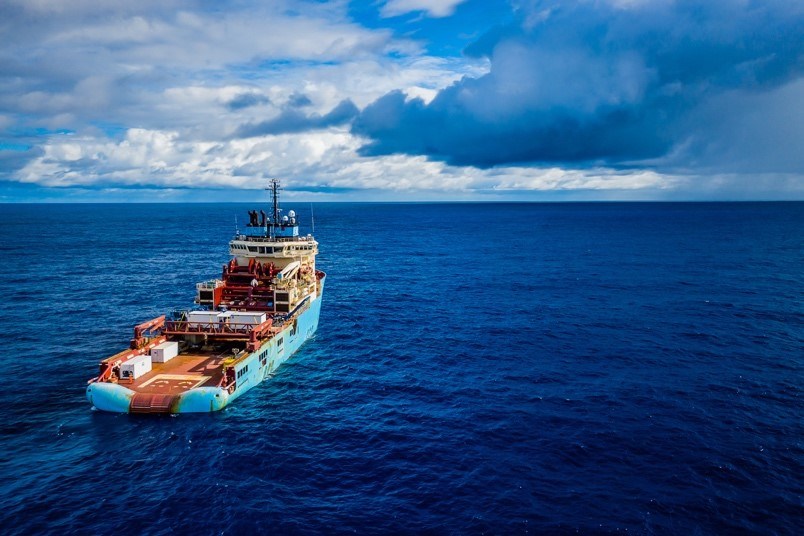Extracting minerals from the ocean floor would negatively impact the tuna industry as the fish is expected to migrate habitat towards areas of the Pacific Ocean currently slated for deep-sea mining activity, a study claims.
The scientific paper, published on Tuesday in the Nature Sustainability journal, centred on three species of tuna — eye, skipjack and yellowfin — that are likely to change their migration patterns due to climate change.
The biomass of the species named in the article will increase by an average of 21% by mid-century in the mineral-rich Clarion-Clipperton Zone (CCZ) a vast area between Hawaii and Mexico that is the target of deep-sea miners.
“These projected increases in overlap indicate that the potential for conflict and resultant environmental and economic repercussions will be exacerbated in a climate-altered ocean,” the study states.
Mining the seabed in the CCZ, the paper claims, could damage the $5.5 billion Pacific tuna industry in several ways. Even companies that plan to scoop up polymetallic nodules located 13,000 feet (4,000 meters) deep, would spawn sediment plumes that could spread over hundreds of feet or more.
Once the mineral-rich potato-sized rocks are transported to the surface and processed, another plume of mining waste would be released back into the ocean, the paper says.
“There is already uncertainty about the impact of climate change on the health and geographic range of tuna. Deep-sea mining will only add to this uncertainty, further threatening tuna species and associated fisheries.” said study co-author Juliano Palacios Abrantes from the University of British Columbia (UBC) in Canada.
“Tuna health could also be harmed by the release of toxic metals during mining, while noise and light from around-the-clock extraction operations could affect the breathing and feeding of tuna and the prey that they rely on for food,” noted Diva Amon, the study’s lead author and a deep sea scientist at the University of California at Santa Barbara.
The peer-reviewed article follows a similar study unveiled in May, which warns that mining the seabed may affect thousands of species recently discovered in the CCZ region, where Canada’s The Metals Company (NASDAQ: TMC), already has two exploration contracts.
It also comes of the heels of a report by non-profit financial think tank Planet Tracker arguing that the price tag of fixing the damage caused by mining the ocean floor would double the cost of extracting the minerals companies have set sights on.
The research was released alongside a letter from Global Tuna Alliance partners, which account for 32% of global sales of the fish. They call for a pause in deep-sea mining development until the socioeconomic and environmental impacts could be more thoroughly analysed.
Crucial week
The publication of the latest study coincides with this week’s meeting of the International Seabed Authority (ISA), the United Nations-affiliated body that regulates deep sea mining.
The Jamaica-based watchdog received in 2021 a formal request from the tiny Pacific Island of Nauru for a commercial deep-sea mining licence. The move triggered a clause that put the ISA on a two-year countdown to consider the application, despite the lack of regulations in place.
Since then, a growing numbers of countries including Canada, Germany, France, Spain, Chile, Costa Rica, New Zealand and Panama among others, have asked the ISA to not rush into enacting mining regulations.
Others, including Norway, are pushing for them as the European nation is opening its sea floor for commercial mineral exploration and extraction in an effort to diversify its economy away from fossil fuels.
The ISA, created in 1994 to manage mining in international waters while at the same time ensuring the protection of the marine environment, is slated to enact draft regulations before the end of the month.
Mounting pressure to pause the approval of a such set of rules and regulations may cause it to defer the process, though experts say that’s unlike as the affair will likely take several years.
Under existing rules, a mining application must be approved by the ISA’s Legal and Technical Commission (LTC), which then issues recommendations to the body’s ruling council. For a licence to be granted, it would need the support of one-third of the council’s 36 members.
Ocean floor mining supporters estimate the activity could provide up to 45% of all the world’s critical metal needs by 2065. They also believe that the UN High Seas Treaty agreed in March by member countries won’t jeopardize exploration efforts.
The accord aims to place up to 30% of the world’s oceans that lie outside national boundaries under protection by 2030.
A study commissioned by The Metals Co says that mining metals such as cobalt and nickel from the seafloor dramatically lowers the environmental impact of producing battery metals the traditional way.



